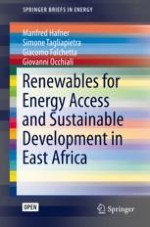This short open access book investigates the role of renewable energy in East Africa to provide policy-relevant inputs for the achievement of a cost-effective electrification process in the region. For each country, the authors review the current situation in the domestic power sector, adopt a GIS-based approach to plot renewable energy resources potential, and review currently planned projects and projects under development, as well as the key domestic renewables regulations. Based on such information, least-cost 100% electrification scenarios by 2030 are then modelled and comparative results over the required capacity additions and investment are reported and discussed. The authors also inquire into some of the key technological, economic, policy, cooperation, and financing challenges to the development of a portfolio of renewables to promote energy access in a sustainable way, including a discussion of the challenges and opportunities that might stem from the interaction between local RE potential and natural gas resources currently under development in the region. To conclude, policy recommendations based on the book’s results and targeted at international cooperation and development institutions, local policymakers, and private stakeholders in the region are elaborated.
